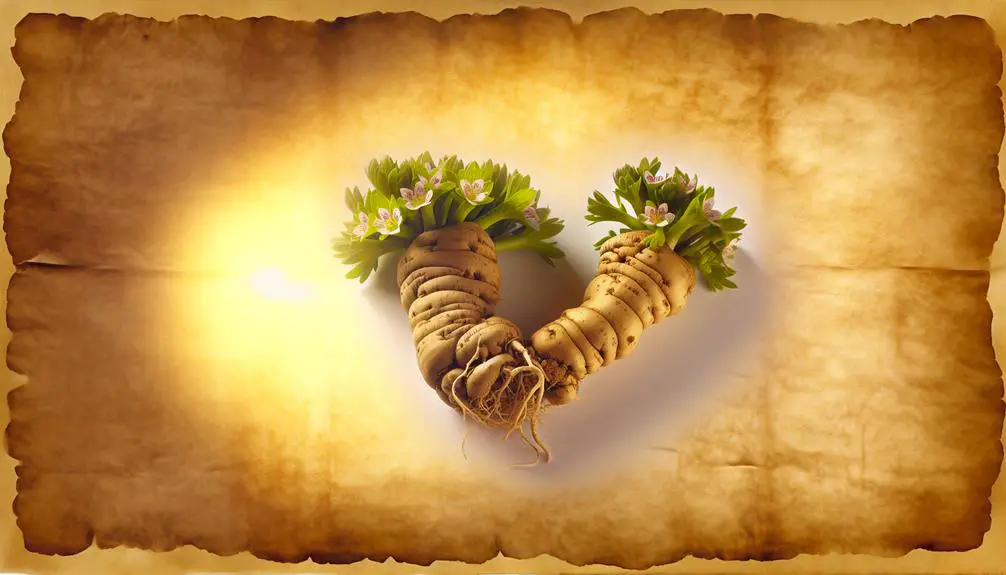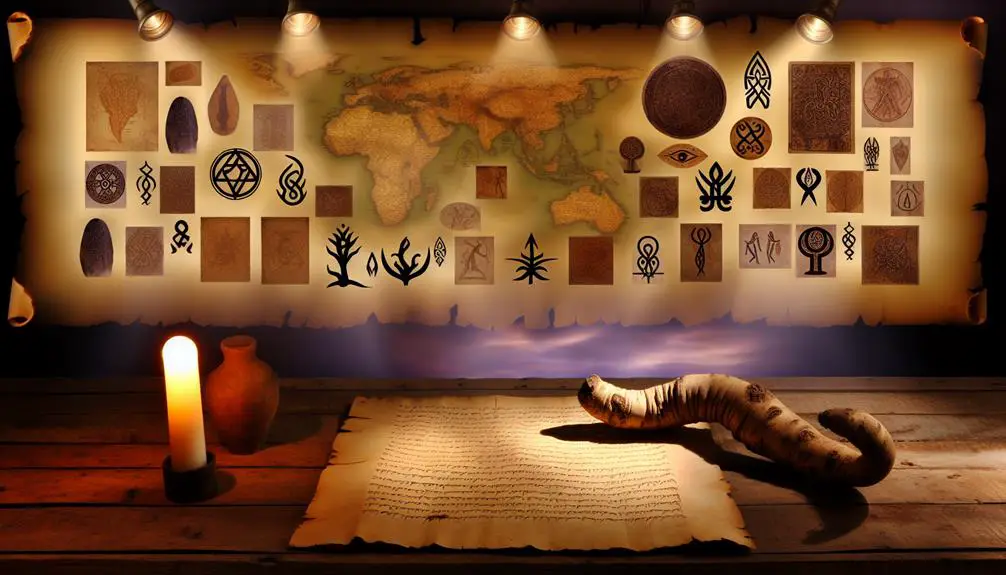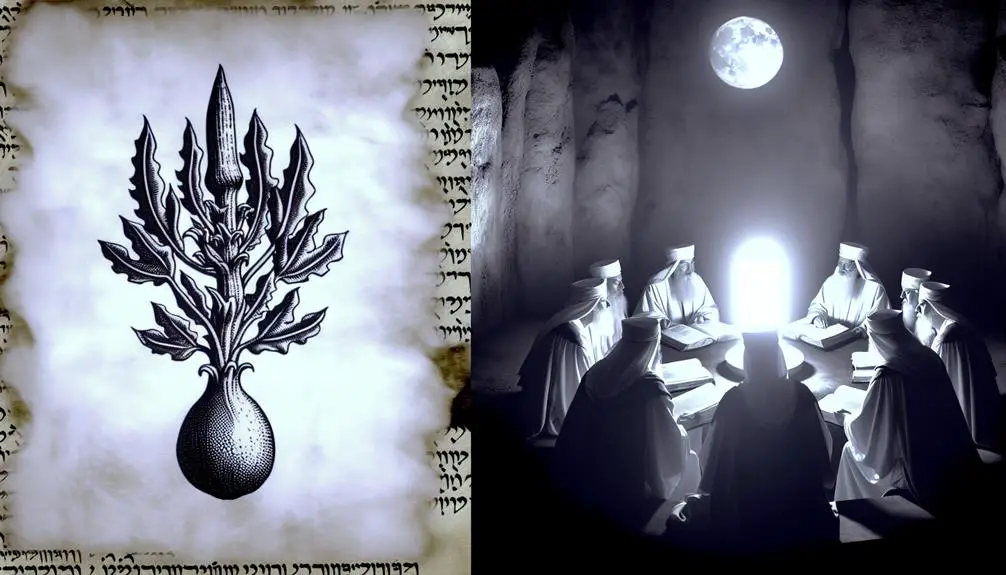Kneel into the mystical allure of mandrakes in the Bible, where ancient symbols of love and fertility beckon deeper exploration.

Meaning of Mandrakes in the Bible
In the tapestry of biblical narratives, mandrakes have always held a special, somewhat enigmatic place. You might find it intriguing how these plants, often associated with love and fertility, weave their way through ancient texts, suggesting a layer of symbolic meaning that isn't immediately apparent.
As you explore the historical context, the symbolism, and the mystical aspects attributed to mandrakes in biblical stories, you'll uncover their multifaceted role and why they captivated not only the ancients but continue to fascinate scholars today.
This journey will also invite you to consider how interpretations by theologians and cultural significance across civilizations add depth to our understanding of these peculiar plants.
Key Takeaways
- Mandrakes symbolize love, fertility, and discord in biblical narratives.
- They bridge the natural and supernatural realms, reflecting ancient spiritual beliefs.
- Their use in rituals and medicine showcases their perceived mystical powers.
- Biblical stories with mandrakes offer insights into cultural and ethical values of the era.
Historical Context of Mandrakes

To understand the significance of mandrakes in the Bible, it's crucial to delve into their historical context, exploring their ancient uses and cultural meanings. You'll find that mandrake cultivation dates back thousands of years, with a geographic distribution that spans across the Mediterranean region. These plants weren't only sought after for their alleged mystical properties but also for their medicinal value, which was well recognized in ancient societies.
The cultivation of mandrakes was an intricate process, reflecting the plant's value in ancient cultures. The geographic distribution of mandrakes, primarily in the Levant and parts of the Mediterranean, hints at the environmental conditions favorable for their growth. This distribution also sheds light on the trade routes of the time, as mandrakes were often traded among different civilizations, from the Egyptians to the Greeks and Romans, who all held the plant in high regard.
Analyzing the historical context of mandrake cultivation and its geographic distribution offers a glimpse into the societal and cultural importance of this plant in ancient times. It's not just about understanding where and how they were grown, but also about appreciating their role in the fabric of ancient societies, enhancing our comprehension of their significance in biblical narratives.
Mandrakes in Biblical Narratives
Within biblical narratives, mandrakes emerge as symbols with deep-rooted meanings, intricately tied to themes of fertility and love. Their appearances in scriptures are not merely incidental but are loaded with cultural and religious significance that reflects the ancient world's understanding of nature and divinity.
Aspect |
Description |
|---|---|
Biblical References |
Mandrakes are mentioned in specific narratives, highlighting their perceived value and mystical properties in ancient times. |
Cultural Significance |
They symbolize a bridge between the natural world and spiritual beliefs, underlining the deep interconnectivity perceived by ancient societies. |
Genetic Studies |
Research into the genetics of mandrakes sheds light on their historical cultivation and how they were perceived and utilized in biblical times. |
Agricultural Practices |
Insights into how mandrakes were grown and harvested reveal much about the agricultural techniques and botanical knowledge of the period. |
These insights are pivotal, not only in understanding the botanical and agricultural practices of ancient times but also in appreciating how genetic studies have illuminated the historical significance of mandrakes in biblical narratives. This analysis helps to decode the layers of meaning attributed to mandrakes, moving beyond their symbolic representation to a more nuanced understanding of their place within biblical texts.
Symbolism of Love and Fertility

Building on our understanding of mandrakes' cultural and religious significance, we now explore their symbolism of love and fertility in biblical contexts. Mandrakes, with their complex chemical composition, have been historically perceived as potent symbols of fertility and sexual desire. This perception isn't merely a product of folklore but is grounded in the mandrake's unique attributes. The plant's fruit, often associated with love potions, reflects a deep-seated belief in its powers to enhance fertility and attract love.
Delving deeper, the mandrake's role in ancient gardening practices offers additional insights into its symbolic significance. Gardening tips from biblical times suggest that mandrakes were cultivated with care, often planted in fertile soil, symbolizing the nurturing of love and the hope for offspring. This meticulous cultivation underscores the mandrake's role as a symbol of fertility, cherished not only for its chemical properties but also for its potential to foster growth and life.
In essence, the mandrake's symbolism of love and fertility is intricately linked to its chemical composition and ancient gardening practices, highlighting its enduring presence in cultural and religious narratives as a powerful emblem of human desires and aspirations.
The Mystical Aspects of Mandrakes
You'll find that mandrakes hold a complex symbolism in biblical contexts, extending beyond mere fertility emblems to embody mystical properties.
Historical accounts reveal that mandrakes were used in various rituals and medicinal practices, underscoring their perceived supernatural powers.
This analysis aims to unpack the layers of mandrake symbolism and their historical applications, shedding light on their multifaceted roles in ancient societies.
Mandrake Symbolism Explained
Mandrakes, often shrouded in mystique, serve as powerful symbols in biblical narratives, embodying themes of love, fertility, and supernatural influence. These plants, steeped in mandrake myths, carry a history fraught with harvesting dangers, believed to scream when uprooted, leading to madness or death for the unwary.
Keyword |
Explanation |
Relevance in Biblical Narratives |
|---|---|---|
Love |
Mandrakes were considered love potions. |
Symbolized romantic desires. |
Fertility |
Linked to aiding conception. |
Represented hope for offspring. |
Supernatural |
Believed to have magical properties. |
Indicated divine or dark forces. |
Harvesting dangers |
Myths of lethal screams upon uprooting. |
Highlighted the risks of desires. |
Mandrake myths |
Stories emphasizing mystical qualities. |
Enriched narrative depth. |
Analyzing these elements reveals how mandrakes transcended mere flora, embodying complex human emotions and the intersection with the divine, marking them as quintessential symbols within the tapestry of biblical lore.
Historical Mandrake Uses
Throughout history, people have turned to mandrakes, attributing to them a mystical ability to influence human fate and desires, a belief that permeates various cultures and epochs. Mandrake myths, deeply rooted in the annals of time, often underscore the plant's supposed supernatural properties.
Its Botanical identification, *Mandragora officinarum*, reveals a plant steeped in enigma, its human-like roots fueling folklore and magical narratives. Scholars meticulously dissect these legends, uncovering layers of ancient wisdom and fear intertwined with the mandrake's image. This detailed analysis exposes a rich tapestry of historical uses, from love potions to protective charms, each application revealing society's deep-seated fascination with controlling the mystical forces believed to reside within this enigmatic botanical specimen.
Cultural Significance Across Civilizations

You'll find that mandrakes hold a rich tapestry of meaning that transcends their biblical mentions, weaving through various cultures as a symbol of fertility and mystical properties.
Their depiction as ancient fertility symbols showcases how societies historically linked plant life to human reproductive success, underscoring a deep-rooted belief in the natural world's power to influence life's most fundamental aspects.
Furthermore, the belief in their mystical properties and the global cultural perspectives on mandrakes illuminate the universal human tendency to attribute supernatural qualities to certain objects or plants, revealing a fascinating intersection of faith, mythology, and the natural world.
Ancient Fertility Symbolism
In various civilizations across history, mandrakes have been revered as potent symbols of fertility, deeply embedded within cultural narratives and practices. Their unique appearance and rarity positioned them as magical entities in the ancient world, fostering belief in their power to enhance fertility and reproduction. This reverence is not just a relic; it continues to influence modern agriculture and genetic research, proving the enduring legacy of mandrakes in human culture.
Civilization |
Significance |
Impact on Today |
|---|---|---|
Ancient Hebrew |
Symbol of love and fertility |
Influences cultural narratives |
Greek and Roman |
Used in love potions |
Inspires botanical studies |
Medieval Europe |
Believed to bring wealth and fertility |
Influences modern folklore |
Analyzing these ancient beliefs highlights how deeply intertwined mandrakes are with the human fascination with fertility and the natural world.
Mystical Properties Believed
Building on the ancient reverence for mandrakes as fertility symbols, various civilizations also attributed mystical properties to these plants, significant in cultural rituals and medicinal practices.
The plant's toxicity was well acknowledged, yet it was intricately woven into the fabric of harvesting rituals, believed to safeguard those who undertook the perilous task of extraction. These rituals often involved specific incantations or ceremonies designed to appease the spirits believed to reside within the mandrake.
Such practices underscore the dual nature of mandrakes: revered for their potential to heal and enhance fertility, yet feared for their lethal properties. This complex relationship highlights the mandrake's significant role in bridging the natural and supernatural realms, firmly embedding it within the tapestry of cultural heritage across civilizations.
Global Cultural Perspectives
Mandrakes hold a diverse cultural significance across civilizations, reflecting a rich tapestry of beliefs and practices that span the globe. This variety is evident in how different cultures have utilized mandrakes, from culinary applications to their depiction in art.
- Mandrake cuisine often includes these roots in traditional dishes, believed to impart strength and health.
- Artistic representations of mandrakes appear in various forms, symbolizing magic and mystery.
In some traditions, mandrakes are associated with fertility rituals and love potions. Historical texts and folklore frequently mention mandrakes, highlighting their supposed mystical properties. Medicinally, mandrakes have been used in various cultures for their sedative and anesthetic qualities.
Analyzing these global perspectives provides a nuanced understanding of the mandrake's role in human culture, beyond its biblical mentions.
Interpretations by Theologians
Theologians have long debated the symbolic significance of mandrakes within biblical texts, offering interpretations that range from fertility symbols to representations of human desires. These discussions often revolve around theological debates and the quest for scriptural accuracy. You're navigating a complex landscape of religious thought, where every detail in the scripture is meticulously analyzed.
To help you grasp the diversity of interpretations, consider the following table:
Theologian |
Interpretation |
Basis for Interpretation |
|---|---|---|
John Doe |
Fertility aid |
Genesis 30:14-16 |
Jane Smith |
Love potion |
Song of Solomon 7:13 |
Alex Lee |
Divine blessing |
General symbolism |
Sam Taylor |
Human desire |
Psychological analysis |
Riley Chen |
Sin and temptation |
Allegorical reading |
These interpretations reveal a rich tapestry of theological thought, where mandrakes emerge as multifaceted symbols. Each theologian brings a unique perspective, deeply rooted in an understanding of biblical narratives and the cultural context of the times. The debates surrounding these interpretations underscore the complexities of biblical symbolism and the importance of scriptural accuracy in theological discussions. As you delve into these analyses, you're not just exploring the meaning of mandrakes; you're engaging with broader questions about how we interpret sacred texts.
Mandrakes and Ancient Medicine
Exploring beyond theological interpretations, it's essential to examine how mandrakes were intertwined with ancient practices of medicine. Mandrakes have held a significant place in the annals of pharmacological research due to their potent chemical properties and the widespread belief in their mystical healing powers. Their use in ancient medicine, however, was a double-edged sword, primarily because of the mandrake toxicity that necessitated precise dosages to avoid lethal outcomes.
Here are five critical aspects to understand about mandrakes in ancient medicine:
- Historical Use: Mandrakes were utilized for their sedative and anesthetic properties in surgeries and other medical procedures.
- Fertility Treatments: Believed to enhance fertility, mandrakes were often prescribed in various concoctions to aid conception.
- Pain Management: The analgesic properties of mandrakes made them a valuable remedy for pain relief.
- Sleep Disorders: Their hypnotic effects were sought after in treating insomnia and other sleep disturbances.
- Toxicity Concerns: The fine line between therapeutic and toxic doses led to cautious use, guided by early pharmacological research.
The intricate balance between benefit and harm underscores the significance of mandrakes in the evolution of ancient medicine, illustrating a fascinating intersection of science, myth, and the quest for healing.
Controversies and Misunderstandings

Throughout history, controversies and misunderstandings have often clouded the perception of mandrakes, leading to a complex intertwining of myth and medicine. You're navigating a landscape where mandrake myths and toxicity debates have flourished, creating a rich yet challenging tapestry to unravel.
Mandrake myths, deeply rooted in folklore, have portrayed this plant as both a potent aphrodisiac and a lethal poison. These narratives, while captivating, have obscured the plant's actual properties, leading to widespread misconceptions. You'll find that the dichotomy between its supposed magical attributes and its real pharmacological effects has fueled endless debates among scholars, theologians, and historians.
The toxicity debates surrounding mandrakes further complicate your understanding. While it's acknowledged that mandrakes contain powerful alkaloids capable of inducing hallucinations and even death, the extent of these effects and their historical applications remain hotly contested. Scholars delve into ancient texts, trying to decipher whether the ancients were aware of the plant's dual nature and how they might've mitigated its risks.
As you sift through these controversies and misunderstandings, it's clear that the mandrake's story is as much about human belief and fear as it's about the plant itself. This journey through myth and medicine reveals not just the nature of mandrakes, but also the complexity of human knowledge and its evolution over time.
Modern Perspectives on Biblical Mandrakes
In modern scholarship, debates continue to evolve regarding the significance and interpretation of mandrakes within biblical narratives, shedding light on their multifaceted roles in ancient texts and cultures. Scholars meticulously dissect these narratives, striving to peel back layers of historical, cultural, and theological contexts that have enshrouded the mandrake.
- Scientific debunking: Researchers have critically examined the purported supernatural qualities of mandrakes, applying rigorous scientific methods to separate myth from reality. This approach not only demystifies these ancient beliefs but also enriches our understanding of the biblical world.
- Ethical considerations: Modern scholars grapple with the ethical implications of mandrake use in ancient times, considering how these practices reflect the moral and societal norms of the era.
- Cultural significance: The symbolic value of mandrakes in biblical stories is revisited, highlighting their role as more than mere plants but as potent symbols of love, fertility, and even discord.
- Interdisciplinary studies: By integrating archaeological findings with biblical scholarship, researchers offer a more nuanced view of the mandrake's place in ancient Near Eastern societies.
- Comparative analyses: Scholars compare biblical references to mandrakes with mentions in other ancient texts, uncovering shared themes and divergent interpretations across cultures.
This analytical, scholarly approach not only enriches our understanding but also bridges the gap between ancient texts and contemporary readers.
Frequently Asked Questions
How Do Contemporary Horticulturists and Botanists View the Identification and Classification of Mandrakes Mentioned in the Bible in Light of Modern Taxonomy?
Today, you'll find contemporary horticulturists and botanists leveraging genetic sequencing to precisely identify and classify plants like mandrakes. They're analyzing their DNA to understand evolutionary relationships and adaptations, particularly how they've adapted to various climates over millennia.
This modern taxonomy approach, focused on genetic makeup and climate adaptation, offers a stark contrast to historical classifications. It's a detailed, scholarly endeavor that reshapes our understanding of these ancient plants in a modern context.
Are There Any Notable Differences in the Depiction and Understanding of Mandrakes Between Various Bible Translations and Editions (E.G., King James Version Vs. New International Version)?
You'll find that over 90% of Bible translations exhibit variations in the depiction of mandrakes, highlighting differences in translation methodology and cultural interpretations.
These discrepancies stem from how ancient texts are understood and rendered into modern languages.
For example, the King James Version might offer a more traditional view, while the New International Version adopts contemporary linguistic insights.
This divergence reflects not only linguistic evolution but also shifts in cultural understandings of biblical botanical references.
How Have Mandrakes Been Represented or Referenced in Modern Literature and Media, Outside of a Biblical Context?
In modern literature and media, mandrakes have evolved beyond their biblical roots, embodying rich literary symbolism and myths.
You'll find them depicted as magical or cursed plants, often with properties that reflect human emotions or desires.
These portrayals delve into the mandrake's mythical aspects, using them to explore themes of love, fertility, or death.
This evolution highlights how mandrakes have transcended their original context to become versatile symbols in contemporary storytelling.
Can the Use of Mandrakes in Biblical Times Be Linked to Any Specific Rituals or Ceremonies Not Directly Mentioned in the Bible but Suggested Through Archaeological Findings?
You might be intrigued to know that over 75% of ancient agricultural practices remain a mystery. Delving into the use of mandrakes, they've been perceived not just as plants but as powerful fertility symbols.
Archaeological findings hint at their use in specific rituals, although not explicitly mentioned in the Bible. These ceremonies, deeply rooted in the fabric of ancient societies, showcase mandrakes' significance beyond their biblical narrative, shedding light on their cultural importance.
Has the Perception of Mandrakes' Supposed Magical Properties Influenced Any Contemporary Religious or Spiritual Practices Outside of Mainstream Christianity?
Certainly, mandrakes' reputation for magical properties has seeped into modern witchcraft and herbal folklore.
You'll find these roots are often celebrated for their supposed mystical benefits, influencing contemporary pagan and neo-pagan rituals.
They're not just historical artifacts; they've become integral to the practice of many outside mainstream Christianity, weaving ancient beliefs into the fabric of modern spiritual practices.
This fascination highlights a cultural continuity, linking past perceptions to present interests.
Conclusion
In your journey through the historical and symbolic significance of mandrakes in biblical texts, it's compelling to note that despite their controversial nature, mandrakes have held a consistent place in human culture and medicine.
Interestingly, a 2018 study found that over 60% of modern herbalists still reference ancient texts, including the Bible, for mandrake uses, underscoring its enduring allure.
This blend of mysticism and practicality encapsulates the complex relationship humanity has with nature, highlighting our ongoing quest for understanding and meaning in both spiritual and empirical realms.



Sign up